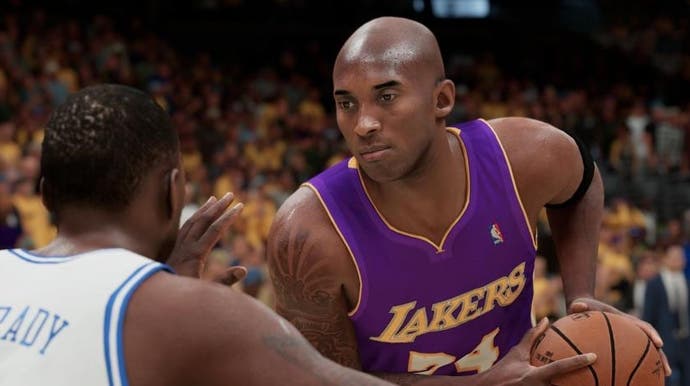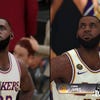NBA 2K21 brings a huge leap in realism for next-gen consoles
PS5 vs PS4 Pro - plus Xbox Series consoles tested.
It's been a long time since we've covered sports titles at Digital Foundry, but with the arrival of NBA 2K21 on the new wave of consoles, we're seeing something genuinely fascinating here, with a proper generational leap in fidelity across the board. To illustrate that, we took a look at the game primarily on PlayStation 5 and PS4 Pro, but we also spent some time with both of the Xbox Series consoles.
Delivering such a big improvement in quality is quite an achievement in my opinion. While it may not seem this way on the surface, sports games are - from what I can tell - one of the more difficult genres to work on. Truncated development schedules require annual entries in each series, meaning less time between each release but more than that, these games have to match up to a properly 'real' experience, often delivered with a TV-like presentation. A game like NBA 2K21 needs to deal with real people in real places performing complex, interlinking actions. If you're off by even a hair, you're diving straight into uncanny valley.
So what makes this so difficult? Well, nailing down the arenas and player likenesses is a huge part of the equation but it's the motion that makes this so difficult. Realistic animation, momentum and collision of each player on the court is a huge challenge. Developer Visual Concepts - whose work on this franchise dates all the way back to the Dreamcast era - is doing some great work here. While it's easy enough to spot the imperfections in the visuals, if you just let the game wash over you, it really begins to look surprisingly authentic in action. When firing on cylinders, it really does look like basketball.
NBA 2K21 includes a vast roster of players from current NBA athletes to legends from the past. By and large, the quality of the rendering of each player is of high quality. The models themselves are intricately detailed with realistic skin shading, sweat and facial expressions. Players look around the court and react to plays in real-time. It's not perfect, as there is a hint of the 'dead eyes' effect, but it's solid. As with last-gen versions, 2K21 uses a cloth simulation for uniforms as well - as you move around the court, the cloth flows and reacts realistically.
But the next-gen difference is delivered in many ways, particularly in terms of materials, shading and lighting. Primarily, based on side by side comparisons, skin receives a significant boost to its specular layer allowing surrounding lights to more realistically play off its surface. The players just look more realistic this time around as a result of this change, to the point where perspiration accumulates on the characters the harder they work. All of this really brings the players to life.
The same is true of the courts, which receive new materials as well producing more realistic results. The color and material response is simply more natural in the next-gen version of the game. But really, the key draw for me is the crowd, which delivers a huge boost over the older consoles. The amount of detail present in each member of the crowd is remarkably impressive. They all move independently and are far more detailed, to the point where even individual fingers are rendered. Yes, if you look too closely, you can spot dead eyes galore, clipping issues and more but, honestly, it works really well during gameplay and replays.
Then there are the reflections on the court itself and this is an area where tried and tested tech wins the day. Based on what I'm seeing, I believe the game uses planar reflections as opposed to ray traced or SSR reflections. Planar reflections are still useful when applied to a single plane such as the court but they're much less flexible in a more complex game world. In this case, the reflection is altered by shaders used on the wood floors to properly distort what you see. The quality and resolution of the reflection seems improved on next-gen versus last. It's even more convincing and highly realistic. The nature of planar reflections also means that objects can be perfectly duplicated and reflections can intersect without issue. The backboard also receives mirror-like reflections which show both the hoop itself and the ball while the net receives nice physics as you jam the ball in.None of these features are new to the next-gen version but everything feels more refined overall.
Speaking of refinement, the upgraded version of 2K21 receives some serious improvement to the user experience as well. Firstly, the entire UI has been completely overhauled - it's entirely unique to the next-gen version. The speed of the storage allows for a more dynamic team selection screen as well since it's possible to rapidly load in new character models. It's a big upgrade, enhanced still further by immense improvements in loading, which basically eliminate all loading screens.
While there's even more about NBA 2K21 to discover, I feel this is a good primer on what you can expect from the new version of the game, but I guess the remaining question here comes down to how this title is delivered on all of the next-gen systems. Well, the good news is that they're virtually identical visually. PS5 and Series X both offer a full native 4K presentation - it looks super sharp on both systems and all visuals appear the same between them. The PS4 Pro version which I used for last-gen testing, by the way, also seems to run at native 4K but obviously with reduced visual fidelity. The one difference here, predictably, lies with the Series S version. This one runs at a native 1080p instead. You get all the same next-gen visuals as its bigger brother, just at a lower resolution.
Performance is also mostly identical: all versions use a mixed frame-rate - gameplay operates at 60fps while replays and interstitial scenes update at 30 frames per second. At these limits, the PlayStation 5 and Series S versions essentially operate flawlessly, while curiously Xbox Series X occasionally has single frame drops. It's all pretty cut and dried, except for one exception: the parametric camera option runs locked at 60fps on PlayStation 5, but does drop frames on Series consoles. Thankfully, this is easily avoided by using other camera angles (and the parametric viewpoint isn't actually that great for gameplay). It's really just an academic difference, but it is there, and PS5 does ultimately have the edge here.
I'd say that NBA 2K21 is a really good release for all consoles and a lot more impressive than I anticipated. While the limitations in the animation are still evident at points, it's the most fluid and realistic looking basketball game I've ever seen. Visual Concepts has set a high bar here when it comes to visual quality and this is just the beginning, really. It's also nice to see that this version is completely separate from the last-gen iteration, suggesting they're building from a new starting point. I expect we'll continue to see things improve over time and I'll be fascinated to see how other companies like EA Sports handle the transition. FIFA 21 has just received its own next-gen upgrade (featuring Frostbite's much vaunted hair physics, no less) and we'll be taking a look at that soon.












